Nowadays, we have plenty of fabrics on the market, but elastane is one of the most common ones. We bet everyone has at least one item that contains this material, that’s why we decided to get you more acquainted with it.
So, briefly, what is elastane? Elastane is a term for an incredibly elastic synthetic fiber also called “spandex” and “lycra”. It is made from polyether-polyurea fiber copolymer and was invented by Duponts company. Manufactures widely use it to combine it with other fabrics, for example, with wool, to bring more elasticity to it.
Ready to explore? Then off we go!
What fabric is elastane?
Elastane (can be called “spandex” and “lycra”) is a synthetic polyurethane fabric that is similar in its main characteristics to rubber.
Suppose we are talking about elastane and its properties, in that case, we have to mention that today it is rarely used in its pure form – exclusively in combination with other varieties of synthetic and natural fibers(with cotton, polyester, and much more).
It is usually included as a part of viscose, cotton, silk, or knitwear garment, which improves their characteristics.
It was produced in the 50s of the last century in the United States. After that, polyurethane threads began to be actively produced in European and Asian countries.
The history of elastane
The material was invented in the 1950s by the American chemist J. Shivers in Delaware State.
This scientist was an employee of the DuPont company, which manufactures synthetic materials (nylon, teflon, kevlar).
For a long time, Shivers studied thermoplastic elastomer, which, when heated, became stretchy and became plastic. As a result, elastane was created, and the company starts to make durable fabric with a density of no more than 1.3 g / cc. cm.
Initially, the material was used to produce corsets, and in the 1960s – for sewing sportswear.
Soon, the fabric gained popularity, they began to make everyday wardrobe items from it, and then festive ones.
How to call elastane correctly?
Lycra, spandex linel, dorastan, and elastane are all fabrics made from polyurethane but produced by different companies. You cannot say that these are some radically different materials, these are brands, brands of fibers.
For example, many types of elastane are called lycra. Invista, the brand owner, defends its trademark and emphasizes that elastane should not be called lycra. For comparison, Dolce & Gabbana clothes cannot be called “Chanel”, although their properties may be similar.
In the US , the word “spandex” is used to name elastane, which we get as a result of rearranging the letters in the word “expand”. Sometimes in the US, we use a synonym for this word – “vairin”. In Europe, the name “lycra” is widespread.
What is elastane made of ?
Elastane fibers are segments that are interconnected by elastic “bridges” – such type a connection does not allow the fabric to tear during stretching and wearing.
When you use a microscope, the structure of the material looks porous and airy.
Polyurethane elastane fibers can be produced in several ways:
- the raw material melts and passed through extruders – molds
- obtained by chemical formation
- formed from dry or wet raw materials using appropriate production methods
The result is a soft, smooth, silky and cool fabric that wraps around the skin like water.
Elastane can be dyed in absolutely any color, filled with a pattern, or left unicolored.
How to use elastane fabric?
Bright stretchy things attract us with their unusual appearance and versatility.
For example, elastane turtlenecks can be bought without trying on – you should only remember desired sleeve length.
Elastane is also suitable for people who save their time and prefer not to iron their clothes.
Even those rare wrinkles on your favorite dress will disappear quickly when you wear your clothes on. And that why we are in love with elastane.
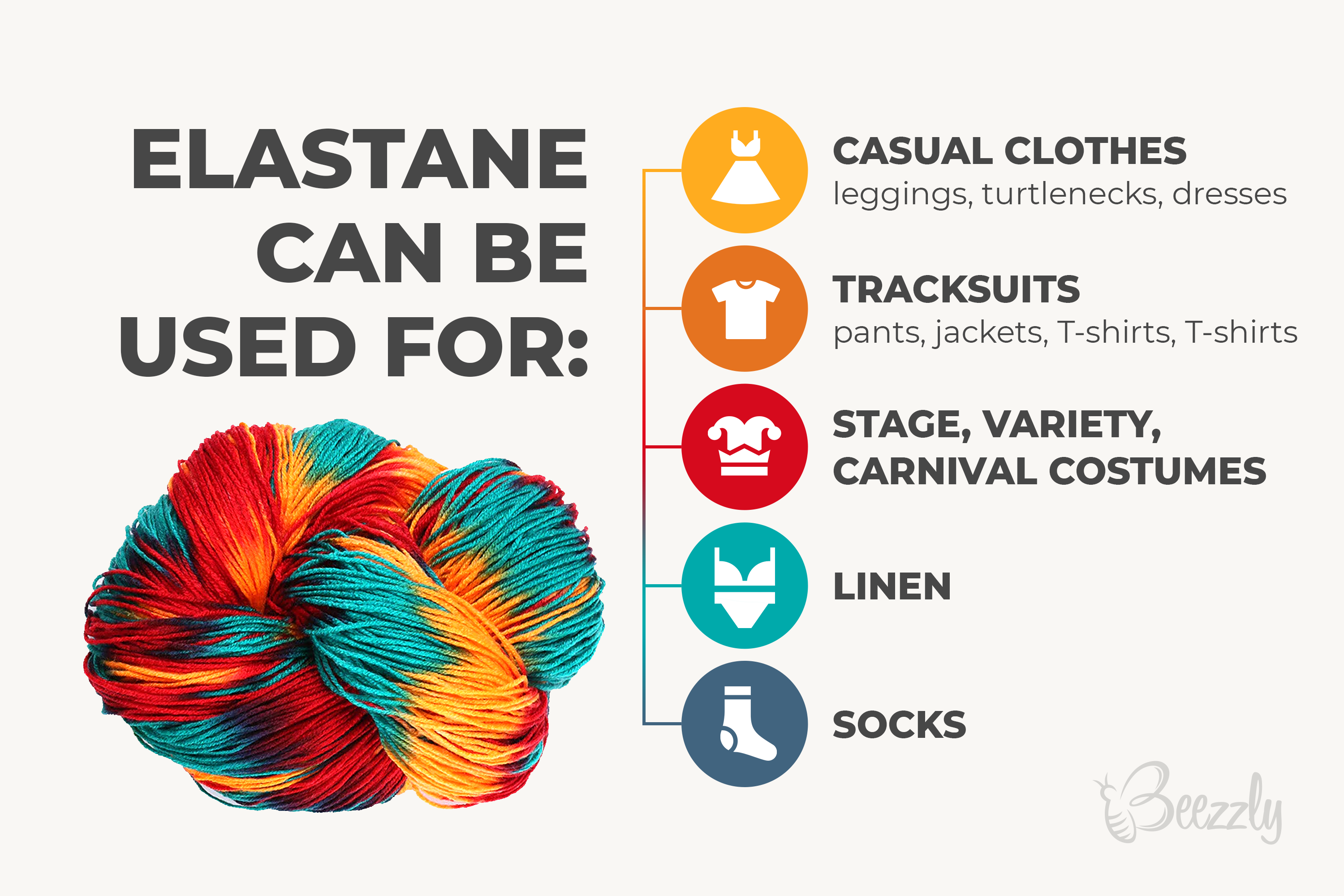
Elastane can be used for:
- casual clothes (leggings, turtlenecks, dresses);
- tracksuits (pants, jackets, T-shirts, T-shirts);
- stage, variety, carnival costumes;
- linen;
- socks.
Elastane is a smooth and shiny fabric. Clothes that are made from it look smart, festive, and modern.
7 Main care rules for elastane fabric
The first and foremost idea is always – check the label first before washing your favorite clothes made from elastane or any other fabric.
- gentle hand wash or you can use a washing machine at 104 degrees
- wring out by hand, without twisting
- colored and white items should be washed separately
- do not use aggressive bleaches and stain removers
- dried naturally, away from heating appliances, or prefer dry flat
- should be ironed with a non-hot iron
- it is better to store clothes made of elastane folded than on the hangers, the clothes can irreversibly stretch
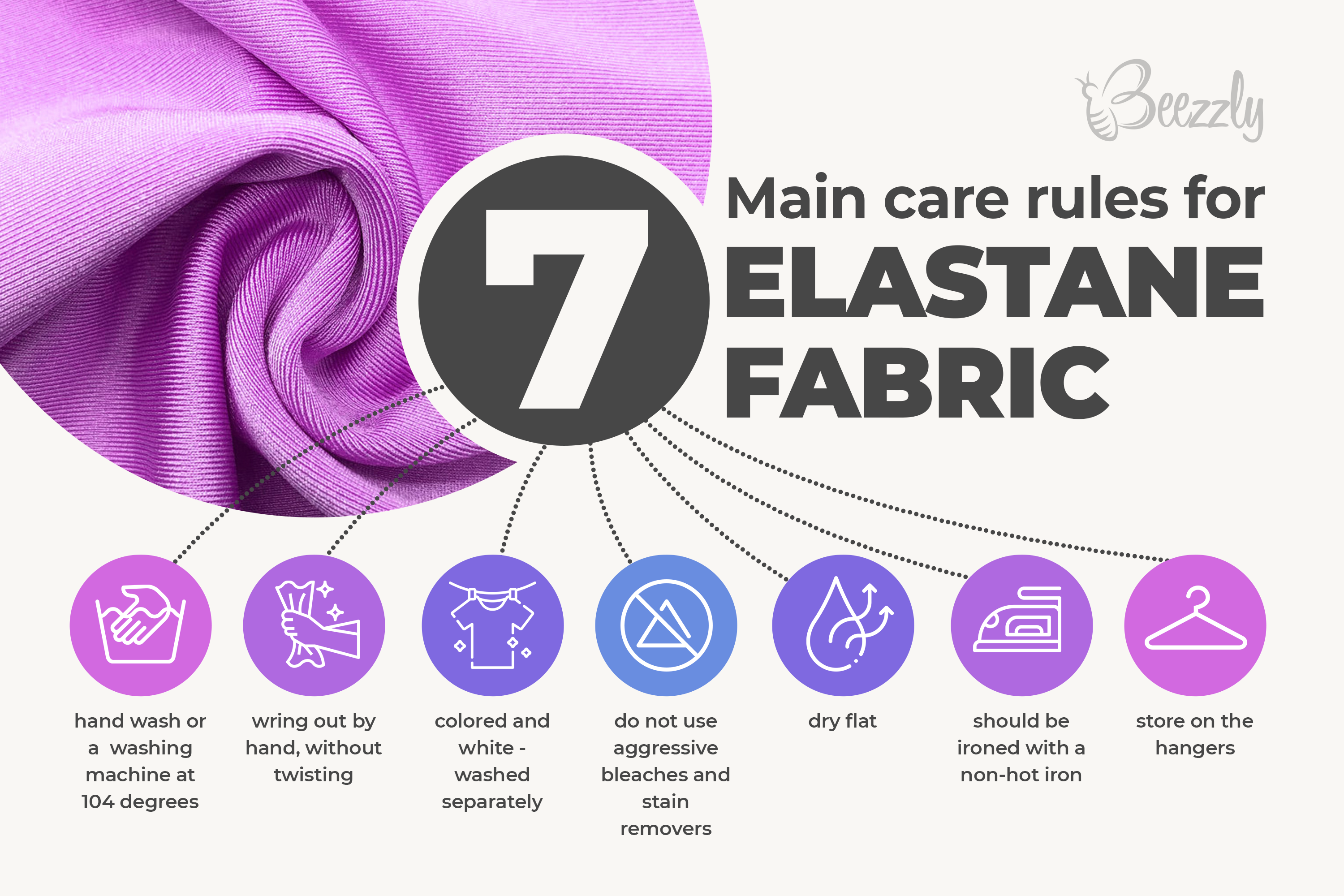
How It Is Produced
To begin with, we need to admit that elastane is a general term used for fabrics or yarns that can be easily stretched. Elastane fibers are man-made and they are always used in conjunction with other fibers but never alone.
To be precise, elastane consists of polyurethane (that is very stretchy) and polyethylene glycol, and due to such content, elastane can achieve a total elongation of more than 700%!
When compared to other popular fabrics like polyester, cotton, and nylon, the elastane has certain significant distinctions that are good to know to be able to choose the proper item in a store.
- Unlike elastane, polyester is way more sturdy and it can not stretch. Another issue about polyester is that it is very predisposed to holding on to the body odor – a problem that elastane has not. In addition, this fabric tends to be way more wear-resistant which means it won’t stretch over time as elastane does.
- As for nylon vs polyester issue, nylon is quite stretchy compared to its counterpart, and it’s known for being strong, and abrasion-resistant. This fabric is very easy to maintain and the fabric itself is very pleasant to the touch, soft and light.
- Soft and breathable cotton is somewhat different on the other hand, that’s why we often find it difficult to choose between cotton or polyester. This material is natural, so it is more absorbent but at the same time strong and abrasion and heat-resistant.
[table id=35 /]
Different types of elastane fabric
The elastane (spandex, lycra) has a lot of varieties.
Any polyurethane fabrics can be differentiated in this way.
Here are types of elastane based on their stretchability:
- two-dimensional – in this case, the elastane stretches in one direction, usually in wide;
- four-dimensional – this kind of fabric has improved stretchability – it stretches both in length and width. This property allows the fabric to be used in sports equipment.
Elastane can be mixed with these fabrics
- Cotton stretch – this name hides a fabric where cotton and elastane are combined. The elastane component can be insignificant – up to 3% and higher – 15 – 20%. This material has improved characteristics and is superior in properties, so it is better than pure elastane and pure cotton;
- Polyester – this fabric contains polyester (85 – 95%) and elastane (5 – 15%). Polyester fabric itself is synthetic, just like lycra. But if cotton or linen is added, then the fabric turns out to be more comfortable and pleasant to the body;
- Nylon – in fact, it is a combination of polyamide and elastane. The fabric is lightweight, dense and waterproof. It is used mainly for sewing outerwear;
- Polyviscose – is a fabric based on viscose and polyester with a small addition of cotton and elastane. If there is more cotton at the base of the thread, then it would be poly-cotton;
- Poly-wool – a blended fabric based on wool and elastane, sometimes containing viscose and polyester. A feature of all mixed materials with the addition of lycra is the gives your sweater high elastisity.
- Crepe – fabric with a high twist of the threads, it is also called crepe. The fabric is easy to identify by its appearance – the front side is smooth and the inside is matte. Crepe twist fabrics with a beautiful drape are suitable for making casual and smart clothes.
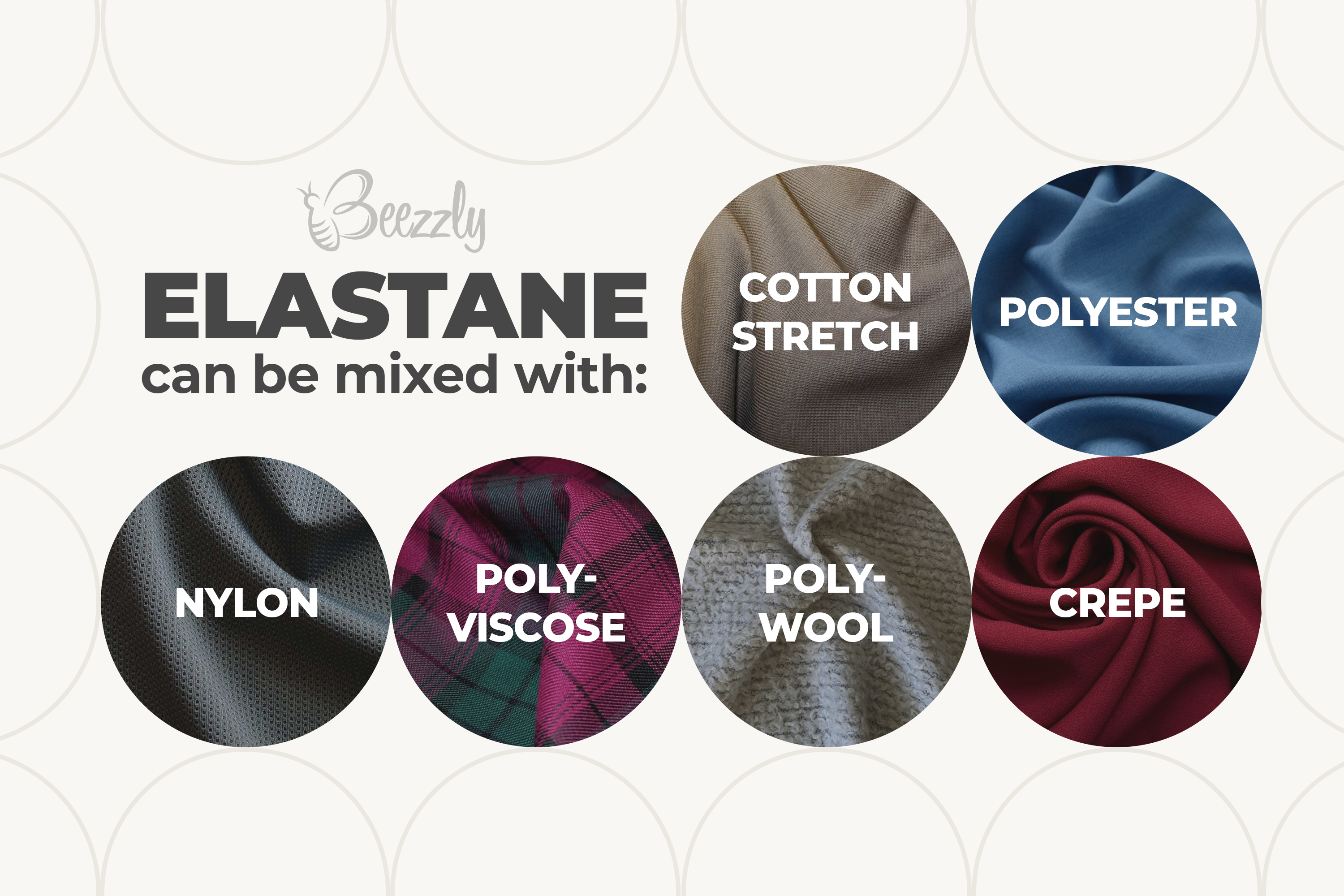
The main advantages of elastane
- Elasticity. Spandex stretches well and can grow up to eight times its length. Moreover, after stretching, it easily and quickly returns to its original shape.
- Strength and wear resistance. Adding spandex to the garment doubles its lifespan.
- Density. Can reach 1.3 g / cc. This creates a stretch effect: outfits containing elastane fits the figure beautifully.
- It is very light
- Softness. Mixed fabric can be draped without problems.
- Subtlety. These synthetics can be added to any other fabrics: it will be woven easily.
- Breathability: the body “breathes”.
- Water resistance.
- Comfort to wear. Things with spandex do not bind the body, do not wrinkle, and do not shrink.
- Resistant to dirt. Almost any stain can be washed off with a simple rinse.
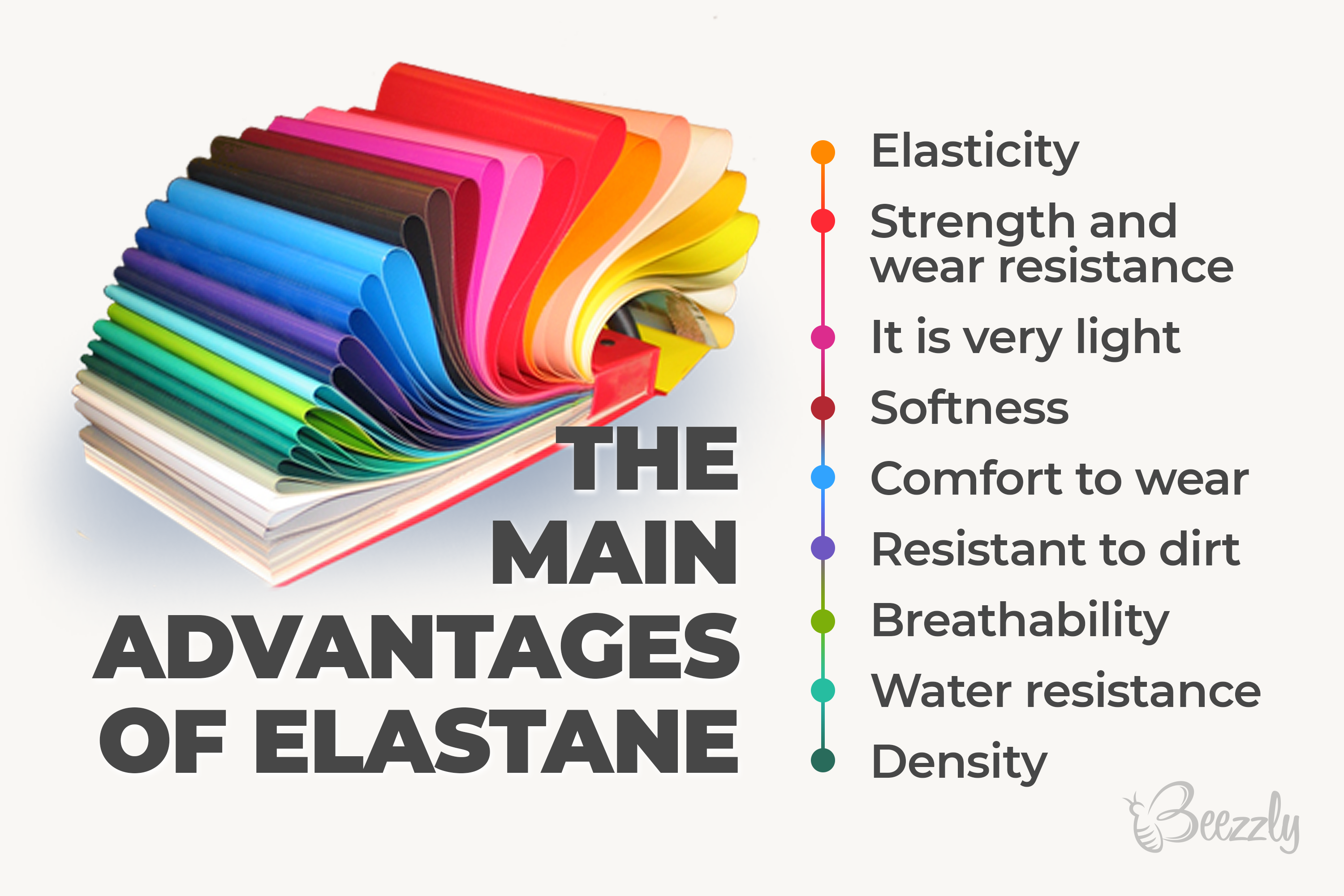
The main disadvantages of elastane
- It is a synthetic fiber
- Spandex can cause allergic reactions
- Intolerance to prolonged exposure to direct sunlight
Why Is It So Special?
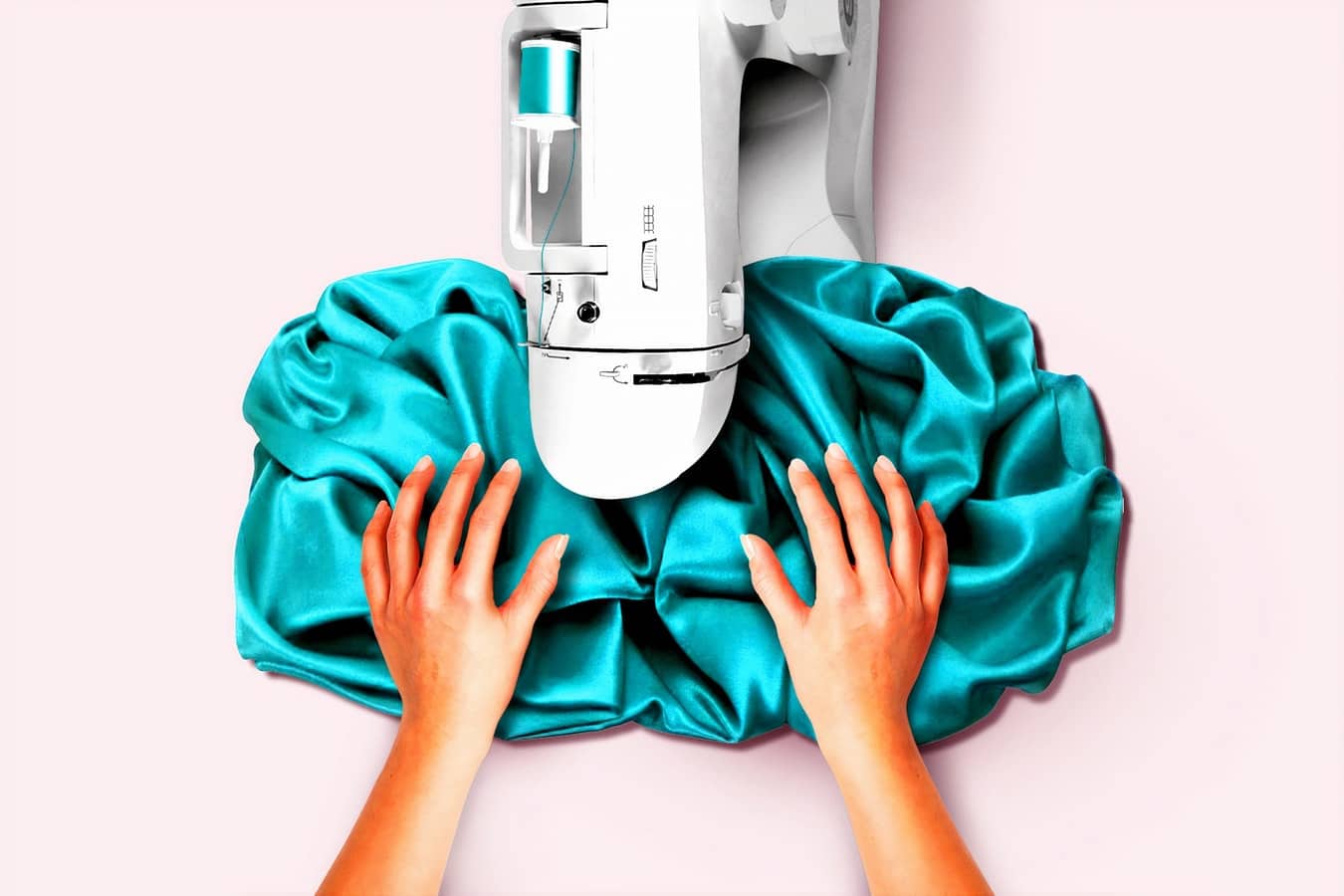
Since this fabric contains plastics or synthetic resins, elastane is extremely elastic and cohesive.
It is known for the high tear length of eight to fifteen kilometers (!), besides, this fiber absorbs very little moisture (less than one percent).
Elastane is famous among the customers because it is very shape-resistant, smooth and light which makes it comfortable to wear.
Since elastane can be easily dried, the items made of it are ok to be laundered at 40 C and sometimes even at 60 C – good news for the housewives and those who like tossing the load to the barrel and press the “start” butting without bothering about the temperature.
Where It Is Used
Of course, clothing is the major area of use of this fabric. It is especially popular as a material for the sportswear and underwear due to the elasticity and the ability to adapt to the body curves and shape.
Socks, leggings, t-shirts, cycling pants, swimwear, and tights – that’s where elastane can be often found.
Is elastane stretchy?
Elastane is a synthetic, stretchy material. Its fibers are often added to natural fabrics to enhance their ability to stretch. Bright, colorful clothes are made of elastane, which stretches well and fits tightly. For more than half a century, this material has been widely used in the textile industry.
Are Spandex and elastane the same thing?
Elastane, elaspam, lycra are synonyms of the term spandex and are the general name for elastic polyurethane types. In the US and Canada, the word “spandex” is used more often, while Europeans prefer the term “elastane”. And yes, Spandex and Elastane are the same things with different brand names.
Elastane vs spandex?
In fact, elastane is the same fabric as spandex, as we call it in Canada and the USA, and elastane is in the more European tradition. If we talk about this material’s structure, then spandex is a segmented polyurethane, which belongs to artificial elastane fibers.
Is elastane safe to wear?
This fabric is durable and is resistant to any negative impacts, well suited for sewing clothing for sports and outdoor activities. In addition, it is safe to wear and environmentally friendly.
The main disadvantages of the fabric can only be attributed to its artificial origin.
Is elastane sustainable?
Unfortunately, elastane is primarily a synthetic and artificial material made in a laboratory environment. Therefore, it cannot be called sustainable. This material will decompose much longer if you compare it, for example, with cotton. But it is safe to wear and cannot harm your health.
Is elastane environmentally friendly?
Elastan cannot be called environmentally friendly fabric. It is undoubtedly a synthetic laboratory product that will decompose for a long time in nature if you compare it with any other natural fabric such as silk or cotton. Moreover, it can be much more durable than cotton.
Choose your garments wisely, and take care!
[wp-faq-schema title=”Frequently Asked Questions”]
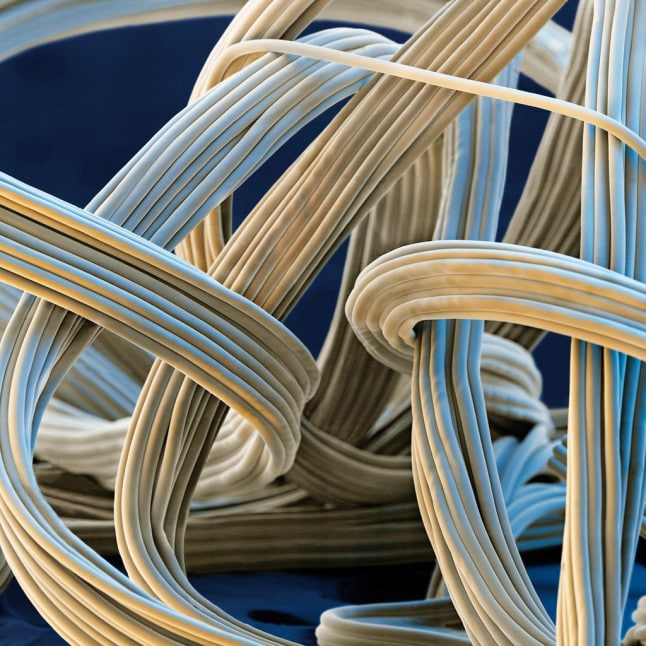
Is elastane a cotton-containing fabric?
No, elastane is a man-made material, but it can be mixed with cotton.
Hi! Please help me to figure it out. Is elastane another name of polyester?
No, these two are different fabrics. They even have different characteristics since polyester isn’t stretch and elastane is.
Is elastane a stretch fabric? Will it be ok for sportswear?
Definitely, it will be a perfect choice for any sportswear. It stretches well, but consider that over time, it can lose its shape.
I need some help from someone who had a similar issue. Do 98 cotton and 2 elastane stretch?
Hey! Yes, such a fabric will stretch a bit. Actually, stretch denim jeans are often made of this blend.
What is the difference between polyester and elastane? I always thought they were the same.
How come? They’re different fabrics. I don’t know the specifics of their manufacturing, but polyester is more sturdy and it’s no stretch, unlike elastane that stretches very well being very elastic.
I can’t make a decision. Is elastane good in jeans? I’d like something that would fit my figure and sit tightly enough.
Choose jeans with elastane, like stretch denim jeans, for instance. They’ll not be too tight and the fabric will be elastic enough.
Is 95 cotton and 5 elastane stretchy? Thanks in advance!
Yeah, it is. It will stretch a bit at the top and bottom, and maybe a bit more on the sides (I judge of my sport t-shirts).
You must understand, I can not wear cotton underwear as I have a reaction of bad itching yet can wear Lace, Nylon, or Cotton Elastane with no problems whatsoever. I cannot wear men’s underwear of cotton so I have to buy women’s like men’s Nylon underwear is very expensive. I have done so for over sixty years.
Hi and thanks for sharing!
Yes it is really tricky to find an underwear without elastane nowadays(